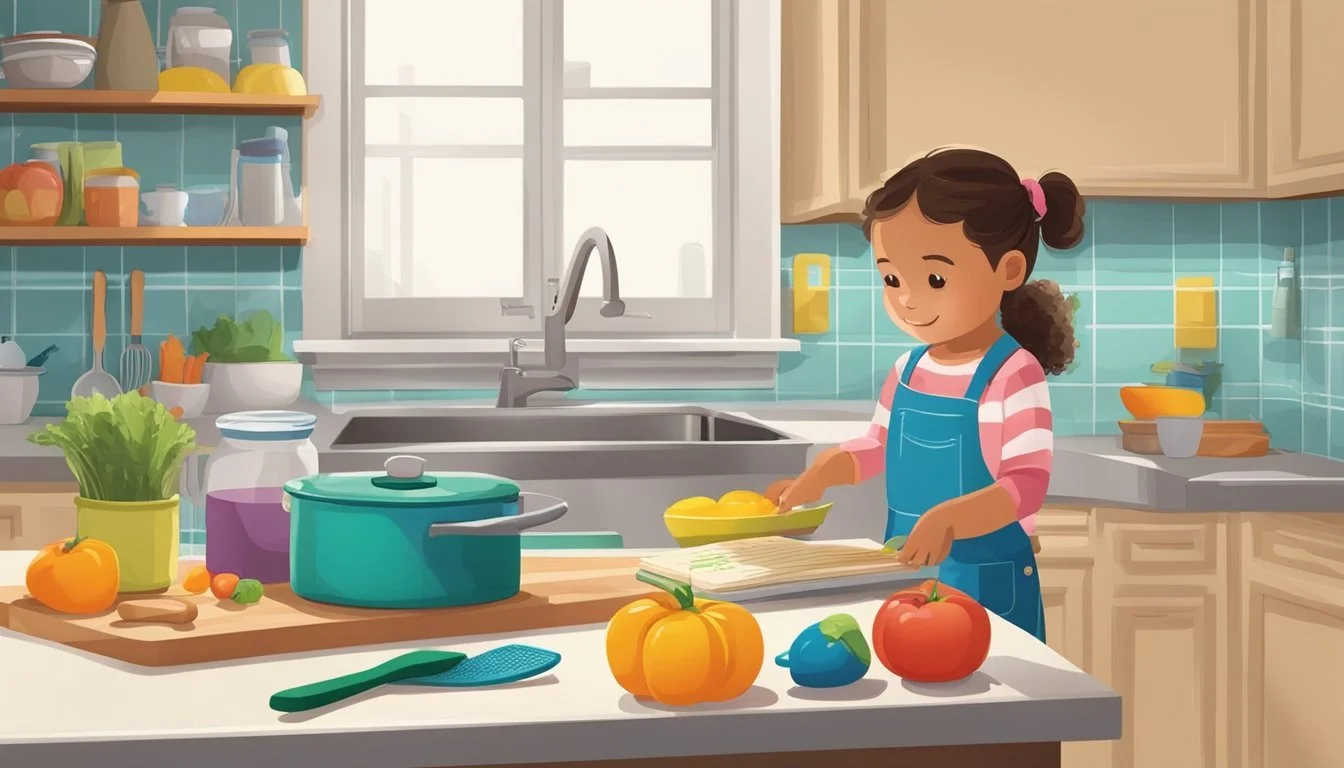How to Cook When You're Introducing Kids to Cooking
Tips for Fun and Safety
Introducing children to the art of cooking is an enriching process that fosters independence and cultivates practical life skills. It's more than just a way to prepare food; it's a means to teach responsibility, enhance fine motor skills, boost confidence, and encourage creativity. As children learn to navigate their way around the kitchen, they also develop an understanding of nutrition and healthy eating habits.
When teaching kids to cook, it's crucial to start with the basics. Setting a strong foundation with simple tasks such as washing fruits and vegetables, spreading butter on bread, or measuring ingredients can build their confidence. It's important to take into consideration the child's age and capabilities to assign appropriate tasks that ensure their safety and keep them engaged.
Creating a learning environment in the kitchen requires patience and guidance. Children need clear instructions and close supervision, especially when they're handling utensils or appliances. By teaching them step by step, answering their questions, and dividing responsibilities, caregivers can effectively turn cooking sessions into valuable teaching moments.
Benefits of Cooking with Kids
Introducing children to the world of cooking offers multi-faceted benefits, ranging from skill enhancement to promoting a deeper understanding of nutrition. Through hands-on experience, children gain confidence, develop a suite of cooking skills, and learn to appreciate healthy food choices.
Building Basic Skills and Confidence
Cooking can serve as a valuable medium to teach children a variety of basic but essential life skills. As they learn to measure ingredients accurately, follow step-by-step instructions, and handle kitchen tools, they develop fine motor skills and problem-solving abilities. Completing a recipe offers them a sense of accomplishment, which in turn boosts their confidence.
Instilling Nutritional Values
In the kitchen, children discover the components of a balanced diet firsthand. Parents can use this opportunity to explain the importance of healthy food selections and the impact of nutrition on the body. Knowing how different foods contribute to their overall well-being encourages children to make healthier choices independently.
Fostering Independence and Creativity
Kitchen activities empower children with the independence to make choices and express themselves creatively through food. They learn how to follow a recipe and also to tweak it to their liking, which not only builds their cooking skills, but also sparks creativity. This aspect of cooking can translate into more confident decision-making in other areas of their lives.
Setting Up a Kid-Friendly Kitchen
When introducing children to cooking, creating a safe, accessible, and engaging kitchen environment ensures they learn effectively while minimizing risks. The kitchen setup adapts to a child’s developing skills at various ages, aligns with safety protocols, and provides suitable tools for a hands-on experience.
Safety First: Equipment and Tools
Safety is paramount when children are involved in cooking. Ovens and stoves present potential hazards, so it’s essential to invest in child-safe equipment whenever possible. Use knob covers or child-proof locks to prevent accidental turning on of the stove. Sharp objects such as knives should be stored securely, and child-friendly versions with dull blades can allow participation without the risk of cuts.
Tools Checklist:
Knob covers for stove
Child-proof locks for oven
Non-slip mats to prevent falls
Kid-sized aprons and oven mitts
Plastic knives and cutting boards
Installing non-slip flooring or using non-slip mats can also reduce the risk of falls due to spills.
Organizing the Kitchen for Accessibility
Arranging the kitchen to be accessible for young cooks encourages independence and learning. Lower countertops or a sturdy step stool can help children reach work areas safely. Store frequently used utensils and measuring cups at a height within their reach, and designate a specific drawer or space for their items.
Organization Tips:
Use a step stool for height adjustments.
Place healthy snacks in low cabinets or drawers.
Organize tools and mixing bowls that children use on accessible shelves.
Age-Appropriate Kitchen Tasks
Children of different ages can handle various tasks in the kitchen. Younger children might start with simple activities like washing fruits and vegetables, while older kids can advance to measuring ingredients and eventually use the stove with supervision.
Tasks by Age:
Ages 3-5: Stirring batter, using cookie cutters
Ages 6-8: Measuring ingredients, simple cutting with supervision
Ages 9+: Operating the stove or oven with guidance, following recipes
Cooking with kids involves progressively introducing more complex tasks, ensuring they are not overwhelmed and that they build confidence as they advance their skills.
Essential Cooking Skills for Kids
Helping kids develop cooking skills not only sets the foundation for healthy eating habits but also enhances their ability to follow instructions and boosts their math and motor skills. Here, we cover the fundamental cooking techniques that every child should learn.
Measuring and Pouring
Accurate measuring and pouring are foundational cooking skills that aid in understanding recipes and achieving consistent results. Children should learn how to:
Use measuring spoons and cups for dry and wet ingredients, ensuring a level measure for accuracy.
Pour liquids steadying their grip on a measuring cup to avoid spills.
Cutting and Chopping Basics
Knife skills are crucial for safety and culinary success. Here's how to get children started:
Introduce them to child-safe knives to cut soft foods such as bananas and cucumbers.
Guide them on how to hold the knife correctly and use a claw grip to hold the item being cut to prevent injuries.
Mixing and Stirring Techniques
Proper mixing and stirring are vital to incorporate ingredients thoroughly and achieve desirable textures. Kids should practice:
Stirring ingredients together with a spoon or spatula until well combined.
Using a whisk for combining dry ingredients or beating eggs to incorporate air for a lighter texture.
By mastering these skills, children will gain confidence in the kitchen and enjoy the interactive learning process cooking provides.
Starting with Simple Recipes
Introducing children to cooking begins with choosing recipes that are easy to follow and execute. Emphasis on simplicity ensures they can see quick results, boosting their confidence and enthusiasm for cooking.
Easy Recipes for Beginners
Simple recipes for children should involve a minimal number of ingredients and steps. One popular option is ABC Pudding, which combines avocado, banana, and chocolate for a delightful treat. The process is straight-forward: blend the ingredients and pour into bowls, making it an excellent first recipe to demonstrate the use of a blender and the skill of pouring. Another ideal beginner recipe is a Strawberry-Banana Smoothie, easily made with strawberries, bananas, and oats, requiring only measuring and blending.
Incorporating Favorite Ingredients
Children are more inclined to participate in cooking when the recipe includes their favorite ingredients. Peanut Butter Balls, for instance, can be made by mixing peanut butter, oats, honey, and chocolate chips—ingredients many children love. This no-bake recipe is both safe and engaging for young cooks. Utilizing real food items like banana slices in simple desserts or avocado as a creamy sandwich spread can instigate a conversation about healthy, wholesome eating.
Meal Planning with Kids
Involving children in meal planning with simple recipes can enhance their decision-making skills and teach them about balanced diets. Start by selecting dishes together for the week, focusing on recipes that integrate fruits and vegetables, like banana pancakes or avocado toast. A straightforward table can help organize the meal plan:
Day Meal Main Ingredients Monday Pancakes Banana, Eggs Tuesday Toast Avocado, Bread ... ... ...
By planning meals, children get a sense of responsibility and the importance of incorporating a variety of real food into their daily diet.
Advanced Cooking Techniques
Introducing children to advanced cooking techniques involves careful guidance towards using kitchen appliances like ovens, stoves, blenders, and mixers. They'll learn temperature control, blending consistency, and the transformation of raw ingredients into complex dishes.
Using the Oven and Stove
When teaching kids to use the oven and stove, focus on safety first. They should understand the importance of preheating the oven to the correct temperature and the method to arrange racks for optimal heat distribution. Likewise, when using the stove, they should know how to adjust flame or heat settings and the significance of pan selection for even cooking.
Oven Skills
Preheating and setting timers
Using oven mitts to place and remove dishes
Stove Skills
Stirring and flipping contents to cook evenly
Regulating the heat to prevent burning
Mastering Blenders and Mixers
Blenders and mixers can be magical to a child, watching solid ingredients transform into smoothies, sauces, or batters. Starting with a blender, teach them how to safely assemble the components, secure the lid, and start with a low setting before gradually increasing speed to blend ingredients to the desired consistency.
Blender Uses
Making smoothies, purées, and soups
Combining wet and dry ingredients for batters
An immersion blender might be more suitable for hands-on blending right in the pot, allowing them to see the blending process up close. Learning to use stand mixers or hand mixers is also important—they should be taught to start at a low speed to prevent splattering and mix until ingredients are just combined for optimal texture.
Mixer Skills
Starting at low speed then increasing as needed
Using the correct attachment (whisk, paddle, or dough hook) for the task
Clean-Up and Kitchen Maintenance
Instilling good clean-up habits and teaching kitchen maintenance is as crucial as the cooking process itself. A well-maintained kitchen promotes safety, hygiene, and a willingness to participate in future cooking activities.
Making Clean-Up Fun and Efficient
Parents and guardians can make clean-up fun by incorporating music or setting up a small reward system. They should demonstrate and explain each task clearly, as children learn best by watching and doing.
Music and Games: They can turn on lively music to create a positive atmosphere or make a game out of clean-up tasks, such as who can wipe the counters the fastest.
Clear Instructions: Provide specific tasks like sweeping the kitchen floor (one child) or wiping the kitchen table (another child).
Efficiency is achieved when everyone understands their role and the clean-up proceeds like a well-coordinated dance.
Teaching Regular Kitchen Maintenance
Regular kitchen maintenance involves daily, weekly, and monthly routines that ensure the kitchen stays clean and operational. Educators should focus on:
Daily Habits: Ensure that the children wash and dry dishes, wipe down surfaces, and sweep floors after every cooking session.
Weekly Tasks: Assign deeper cleaning tasks such as organizing the pantry or cleaning the refrigerator. These can be rotated among children to provide a variety of experiences.
Highlighting the importance of careful handling of cleaning supplies and tools will teach children both the skills and the respect necessary for kitchen work.
By teaching these habits, children learn the value of cleanliness and organization, setting the foundation for excellent culinary practices in the future.
Incorporating Cooking Lessons into Daily Life
Involving children in cooking activities provides a hands-on approach to learning culinary skills. It equips them with the ability to prepare simple meals while integrating educational concepts in an enjoyable environment.
Integrating Lessons with Daily Meals
Practical Application: Each meal presents an opportunity for children to practice basic culinary tasks. Parents can craft a meal plan that incorporates varied and simple dishes to build a diverse set of skills. For instance, a week's menu could look like this:
Monday: Tossed salad (chopping, peeling, dressing)
Tuesday: Grilled cheese sandwiches (pan-frying, flipping)
Wednesday: Fruit smoothies (measuring, blending)
Thursday: Pasta with marinara (boiling, saucing)
Friday: Omelette (cracking eggs, whisking, cooking)
Parents can align these meals with the appropriate cooking lessons, ensuring that each task is age-appropriate and safe. This methodical approach allows kids to gradually build their confidence as they master each task.
Creating a Routine for Cooking Together
Set Expectations: Establishing a routine for cooking together gives structure to the learning process. A shared schedule can include designated days and times when kids know they will be participating in meal prep. This could be as simple as setting aside Sunday afternoons for baking or Tuesdays and Thursdays for making dinner.
Progressive Learning: Cooking with kids should follow a progressive model similar to the "kids cook real food" approach. The first encounter might involve watching an adult handle tasks, the next might involve assisting, and finally, the child might attempt the task independently. For example:
Lesson Introduction: Parents demonstrate how to make a stir-fry, explaining each step.
Guided Practice: During the next session, kids help by washing vegetables and stirring the pan.
Independent Attempt: Children take the lead on the stir-fry preparation, with the parent available for guidance.
After each stage, parents can offer feedback and note the child’s progress on a cooking lesson chart. A consistent routine reinforces the skills learned and provides a rhythm that children can anticipate and prepare for.
Choosing the Right Cooking Class for Your Child
When selecting a cooking class, parents should focus on the program's structure and relevancy to their child's age and skills. This ensures a safe, enjoyable, and educational experience that aligns with their developmental stage.
Evaluating Cooking Programs and Curricula
Parents should look for a cooking program that offers a clear outline of learning objectives and cooking lessons. The curriculum should detail the skills and recipes that will be taught, along with the progression from simple to more complex tasks. Here are key elements to consider:
Lesson Structure: Each session's format, including the introduction of new skills, practice opportunities, and feedback mechanisms.
Recipe Selection: Recipes that blend learning and enjoyment, providing a chance for children to help with meal planning and understand the nutritional aspects of food.
Safety Measures: Emphasize the importance of age-appropriate safety guidelines and practices taught within the classes.
Instructor Qualifications: Ensure that the instructors are experienced in teaching cooking to children and hold credentials in culinary arts or education.
Identifying Age-Appropriate Cooking Classes
Choosing a class that meets a child's developmental capabilities is crucial. Age-appropriate classes not only ensure safety but also enhance learning and interest. Here's how to identify them:
Ages 5-7: Classes should focus on basic skills, like measuring, mixing, and spreading. Simple, tangible results like making a sandwich or a fruit salad are rewarding for young chefs.
Ages 8-10: At this stage, children can manage more complex tasks like peeling, cutting with supervision, and following simple recipes. Classes might introduce baking and stovetop cooking with assistance.
Ages 11 and up: Older children can handle involved recipes and cooking tools. Classes can cover meal preparation, advanced cutting techniques, and even meal planning, empowering them to contribute to family meals.






